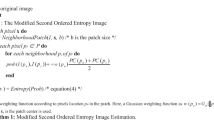Abstract
Automatic registration of multimodal images has proven to be a difficult task. Most existing techniques have difficulty dealing with situations involving highly non-homogeneous image contrast and a small initial overlapping region between the images. This paper presents a robust multi-resolution method for regis tering multimodal images using local phase-coherence representations. The proposed method finds the transformation that minimizes the error residual between the local phase-coherence representations of the two multimodal images. The error residual can be minimized using a combination of efficient globally exhaustive optimization techniques and subpixel-level local optimization techniques to further improve robustness in situations with small initial overlap. The proposed method has been tested on various medical images acquired using different modalities and evaluated based on its registration accuracy. The results show that the proposed method is capable of achieving better accuracy than existing multimodal registration techniques when handling situations where image non-homogeneity and small overlapping regions exist.









Similar content being viewed by others
References
Simmons, A., Tofts, P., Barker, G., & Arridge, S. (1994). Sources of intensity nonuniformity in spin echo images at 1.5T. Magnetic Resonance in Medicine, 32(1), 121–128.
Oghabian, M., Mehdipour, S., & Alam, N. (2003). The impact of RF inhomogeneity on MR image non-uniformity, Proc. Image and Vision Computing New Zealand.
Nelder, J., & Mead, R. (1965). A simplex method for function minimization. Computer Journal, 7, 308–313.
Collignon, A., Maes, F., Delaere, D., Vandermeulen, D., Suetens, P., & Marchal, G. (1995). Automated multi-modality image registration based on information theory. Proceedings of information processing in medical imaging (pp. 263–274).
Viola, P., & Wells, W. (1997). Alignment by maximization of mutual information. International Journal of Computer Vision, 24(2), 137–154.
Studholme, C., Hill, D., & Hawkes, D. (1999). An overlap invariant entropy measure of 3D medical image alignment. Pattern Recognition, 32(1), 71–86.
Crum, W., Hill, D., & Hawkes, D. (2003). Information theoretic similarity measures in non-rigid registration. Proceedings of information processing in medical imaging (pp. 378–387).
Pluim, J., Maintz, J., & Viergever, M. (2003). Mutual-information-based registration of medical images: A survey. IEEE Transactions on Medical Imaging, 22(8), 986–1004.
Mellor, M., & Brady, M. (2005). Phase mutual information as a similarity measure for registration. Medical Image Analysis, 9, 330–343.
Felsberg, M., & Sommer, G. (2001). The monogenic signal. IEEE Transactions on Signal Processing, 49(12), 3136–3144.
Wong, A., Bishop, W., & Orchard, J. (2006). Efficient multi-modal least-squares alignment of medical images using quasi-orientation maps. Proceedings of international conference on image processing, computer vision, and pattern recognition.
Haber, E., & Modersitzki, J. (2006). Intensity gradient based registration and fusion of multi-modal images. Proceedings of the international conference on medical image computing and computer assisted intervention (pp. 726–733).
Orchard, J. (2007). Globally optimal multimodal rigid registration: an analytic solution using edge information. Proceedings of the IEEE international conference on image processing.
Liu, J., Vemuri, B., & Marroquin, J. (2002). Local frequency representations for robust multimodal image registration. IEEE Transactions on Medical Imaging, 21(5), 462–469.
Hemmendorff, M., Andersson, M., Kronander, T., & Knutsson, H. (2002). Phase-based multidimensional volume registration. IEEE Transactions on Medical Imaging, 21(12), 1536–1543.
Wong, A., & Bishop, W. (2008). Efficient least squares fusion of MRI and CT images using a phase congruency model. Pattern Recognition Letters, 29(3), 173–180.
Morrone, M., & Burr, D. (1998). Feature detection in human vision: a phase-dependent energy model. Proceedings of Royal Society of London B, 235, 221–245.
Kovesi, P. (2003). Phase congruency detects corners and edges. Proceedings of Australian pattern recognition society conference (pp. 309–318).
Wang, Z., & Simoncelli, E. (2004). Local phase coherence and the perception of blur. Advances in neural information processing systems, 16, May.
Selesnick, I., Ivan , W., Baraniuk, R., & Kingsbury, N. (2005). The dual-tree complex wavelet transform. IEEE Signal Processing Magazine, 22(6), 123–151.
Perona, P., & Malik, J. (1990). Scale-space and edge detection using anisotropic diffusion. IEEE Transactions on Pattern Analysis and Machine Intelligence, 12(7), 629–639.
Orchard, J. (2005). Efficient global weighted least-squares translation registration in the frequency domain. International conference on image analysis and recognition (Vol. 3656, pp. 116–124). LNCS.
Omanovic, M., & Orchard, J. (2006). Efficient multimodal registration using least-squares. Proceedings of the international conference on image processing and computer vision.
Boggs, P., & Tolle, J. (1995). Sequential quadratic programming. Acta Numerica, 151
Johnson, K., & Becker, J. The whole brain atlas. http://www.med.harvard.edu/AANLIB/home.html.
Collins, D., Zijdenbos, A., Kollokian, V., Sled, J., Kabani, N., Holmes, C., & Evans, A. (1998). Design and construction of a realistic digital Brain phantom. IEEE Transactions on Medical Imaging, 17(3), 463–468.
Acknowledgements
The authors would like to thank the Natural Sciences and Engineering Research Council (NSERC) of Canada for funding this project. The authors would also like to thank the NLM, Dr. Keith A. Johnson, and the McConnell Brain Imaging Centre at McGill University for the test data.
Author information
Authors and Affiliations
Corresponding author
Rights and permissions
About this article
Cite this article
Wong, A., Orchard, J. Robust Multimodal Registration Using Local Phase-Coherence Representations. J Sign Process Syst Sign Image Video Technol 54, 89–100 (2009). https://doi.org/10.1007/s11265-008-0202-x
Received:
Revised:
Accepted:
Published:
Issue Date:
DOI: https://doi.org/10.1007/s11265-008-0202-x




